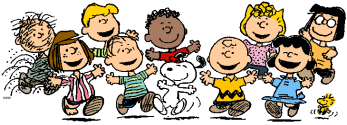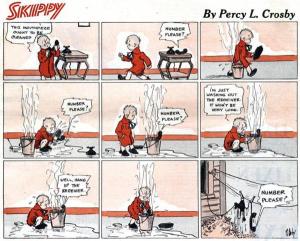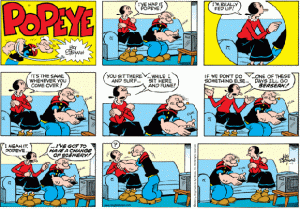Playwright’s Background
CCSS. ELA-LITERACY.RH 6-8.8
Charles Shulz: Writer and Illustrator (1922-2000)
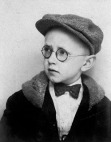
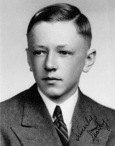
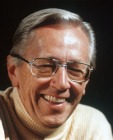
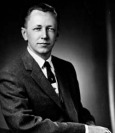
 (Images from https://schulzmuseum.org/about-the-man/schulz-biography/)
(Images from https://schulzmuseum.org/about-the-man/schulz-biography/)
Charles Schulz is the world known creator and cartoonist behind Peanuts, a globally popular comic strip that persisted into television, books, and other popular merchandise.
Schulz was born on November 26, 1922, in Minneapolis, Minnesota. Charles was given the nickname “Sparky” after the horse Spark Plug from the Barney Google comic strip two days after birth by his uncle. Shulz’s father, Carl, was of German heritage and his mother, Dena, came from a large Norwegian family. The family made their home in St. Paul, where the father, Carl, found work as a barber. Growing up both father and son traditionally shared Sunday mornings with a ritual of reading comic strips found in the newspapers. Schulz found particular interest in strips like Skippy, Mickey Mouse, and Popeye.
Through his strong enjoyment from strips he found his passion and desired nothing more than to become a cartoonist. In 1937 a publication of his drawing Spike, the family dog, was a proud moment for young teen Schulz. It sparked up his motivation to take his artistic study to a new level. As a senior in high school and with the support of his mother, he completed a correspondence cartoon course with the Federal School of Applied Cartooning (now called the Art Instructions School).
As Schulz continued to advance in his natural talent of cartoon art his unique artistic style from the late 1920s through the 1940s took a cartoon art shift. Newspaper editors in the late 1940s and 50s began pushing cartoonist to shrink strip size, minimize pen strokes, and sharpen their humor with daily gag jokes and humor for a more educated audience. Schulz’s dry and intellectual humor was a natural fit for the evolving cultural standards of the mid-20th century comics.
Two life changing events that affected Schulz’s life immensely was in 1943 when his mother, whom he was extremely close with, passed away at the age of fifty from cervical cancer. Due to that saddening tragedy Schulz decided to board a troop train where he began his army career in Camp Campbell, Kentucky. Although Schulz was proud of his achievements and leadership roles during his service in the army; the experience of losing his mother and the realities of war was his most unforgettable and catastrophic time of his life.
After returning from the war in the fall of 1945, Schulz settled with his father in the small apartment over the barber shop that he owned. There Schulz was determined to regain his passion of becoming a professional cartoonist. While Schulz worked as an art instructor he created his first comic strip, Li’l Folks, and was published in a local newspaper. He then sold the comic strip to United Feature Syndicate in 1950 where the company retitled his work to Peanuts. Many of Schulz inspiration for his comic strip were based off of his own personal experiences and memories. For example, Charlie Brown was based on himself and the inspiration for Snoopy came from remembrance of his childhood pet.
The first Peanuts strip appeared on October 2, 1950, in seven newspapers nationwide. Even though being a professional cartoonist was Schulz life-long objective, at the age of 27, he never expected the global impact and longevity his seemingly- simple four-panel creation would have on everyone. The popular appeal of the Peanuts comic strips constantly found ways for his audience to build connections and relations from his strips, an experience that other cartoonist seemed to not possess within their own comics. As his audience formed an addiction to the Peanuts they were able to watch the character’s personalities grow and unfold, while creating a deep attachment to the characters. For example, readers would intimately understand Linus’ attachment to his security blanket, Charlie Brown’s heartache over the Little Red- Haired Girl, or even Peppermint Patty’s interest in sports but failure in the classroom. One of the most popular character developments that took Schulz storylines in increasingly new directions was Snoopy and his evolution from a four-legged pet to a two-legged imaginative individual in the strip. It was Schulz humor, sarcastic, bittersweet, silly, sentimental, and gloomy characteristics that he infused in his comics that kept his well- known and comfortable characters fresh enough to constantly attract new readers while keeping his faithful followers coming back for more.
When Schulz announced his retirement in December 1999, the Peanuts comic strip was featured in newspapers worldwide, with book collections translated in over 25 languages. He has been awarded with the highest honors from his fellow cartoonist and colleges, received Emmy Awards for his animated specials, been recognized by the U.S and foreign governments, and had NASA space crafts named after his Peanut characters. But best of all has been inspirational to individuals all over the world.
Created by: Francis Cabigas
Works Cited:
“Charles Schulz.” Bio. A&E Television Networks, 2015. Web. 19 Apr. 2015.
Charles M. Schulz Museum. “Charles M. Schulz Biography”. Charles M. Schulz Museum. N.p. n.d. Web. 19 April. 2015.
The making of the musical production, You’re a Good Man Charlie Brown:
CCSS.ELA-LITERACY.RH 6-8.8  You’re a Good Man, Charlie Brown is a musical comedy created by Clark Gesner, based on the characters in the comic strip Peanuts, created by the well- remembered Charles Schulz. Gesner inspirationally constructed the music and lyrics to the musical comedy in 1967. Till this day You’re a Good Man Charlie Brown has been one of the top musical productions for amateur theatre due to its small cast and uncomplicated staging. Collaborator John Gordon is credited for creating the book of the major production.
You’re a Good Man, Charlie Brown is a musical comedy created by Clark Gesner, based on the characters in the comic strip Peanuts, created by the well- remembered Charles Schulz. Gesner inspirationally constructed the music and lyrics to the musical comedy in 1967. Till this day You’re a Good Man Charlie Brown has been one of the top musical productions for amateur theatre due to its small cast and uncomplicated staging. Collaborator John Gordon is credited for creating the book of the major production.
During the beginning of the creative process of producing the songs for You’re a Good Man Charlie Brown Gesner was unable to be granted the permission he needed from the United Features Syndicate in order to use the Peanut characters in his songs. Gesner took it into his own hands to personally send Schulz a tape of some of the songs he has created. Schulz was extremely delighted by the songs that he approved Gesner the permission he needed to use the Peanut characters in his songs. Gesner did not originally plan to create a musical production till producer Arthur Whitelaw encouraged Gesner to turn his album into one.
Created by: Francis Cabigas
Works Cited:
You’re a Good Man, Charlie Brown. Wikipedia: The Free Encyclopedia. N.p. 20 March. 2015. Web. 19 April. 2015.
